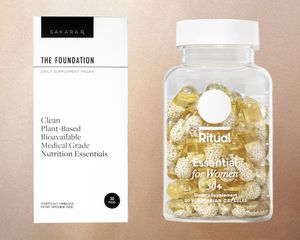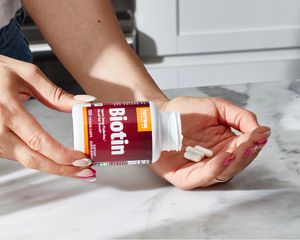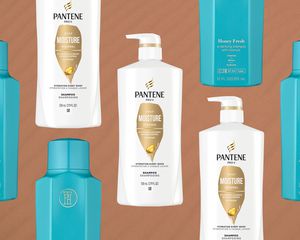:max_bytes(150000):strip_icc()/is-seitan-bad-for-you-5074882_primary-50f982a6bc8a4f948e90bd39f9e5a1e4.jpg)
Stocksy / Design by Bailey Mariner
Where tofu used to be the only well-known meat substitute, tempeh and soy protein quickly caught on. And now, seitan is here to switch things up. Pronounced say-tan, you may wonder if seitan is actually a good source of protein for vegetarians and folks looking to up their amino acid intake sans the animal products.
To uncover just that, we chatted with a couple of dietitians (and one famous Olympic chef and restaurateur) for everything there is to know about the buzzy protein source. If you’re curious how it holds up to its animal counterparts, whether or not it's too processed, or if it’s worth adding into your diet as a whole, keep scrolling.
Ahead, everything you need to know about seitan in regards to your health.
What Is Seitan?
According to NYC-based dietitian Jennifer Maeng of Chelsea Nutrition, seitan is made from gluten and water and is often promoted as a high-protein, low carb meat alternative. “Unlike tofu and tempeh, which are made from soy, seitan is a great meat alternative for vegans and vegetarians with a soy allergy,” she explains, noting, however, that those who have celiac disease or gluten sensitivity should avoid seitan because of the gluten content.
One of the biggest concerns with meat alternatives is the texture. When it comes to seitan, Centr chef Dan Churchill says that it has a firm, chewy texture that stands up to that of meat. Of course, if you’re a vegetarian and don’t wish to consume things that mimic animal textures, this might not be considered a good thing.
If you’ve never heard of seitan, dietitian and Integrated Eating founder Maria Sorbara Mora says that there’s a good chance that you’ve heard of it by its other names: wheat meat, gluten, wheat protein, or wheat gluten. “It is most often used as a base in meatless deli slices, hotdogs, and bacon, as well as products that look like meat, like grounds and strips,” she adds.
Is Seitan Bad For You?
Often meat alternatives are assumed to be healthier than their animal counterparts. While this is often true in terms of cholesterol and fat content, Maeng points out that due to how processed meat alternatives can be makes them a little bit questionable. “Watch the labels of pre-packaged [highly-processed] seitan, because it can have a high salt content,” she warns, again noting that those who have celiac disease or gluten sensitivity should avoid seitan because of the gluten content.
Although Maeng urges folks to monitor their seitan consumption, Mora says that, overall, seitan is a pretty good choice when it comes to meat alternatives. After all, all meat alternatives are processed to some extent, and seitan has a plethora of health benefits that make it especially appealing.
The Benefits of Seitan
- Nutritious
- High in protein
- Good source of healthy minerals
- Low in calorie, carbs, and fat
- More bioavailable
“Seitan is nutritious—it is high in protein and contains many minerals including selenium, iron, phosphorus, calcium, and copper,” Maeng says, noting that a single serving of seitan is low in calories, carbohydrates, and fat.
Churchill, who was Lindsey Vonn’s chef for the 2018 Olympics, adds to this, noting that there’s evidence to suggest that plant-based proteins are more bioavailable to their meaty counterparts, meaning their nutrients can potentially be better absorbed into the body. “This goes for tofu as well,” he says. “If you need more protein in your diet, and are vegetarian or vegan, or avoiding meat for any reason, it could be an option for you. It could also be something fun to experiment with making yourself—if you're up for it!”
Byrdie Tip
Much like tofu and tempeh, seitan easily absorbs other flavors. Try seasoning seitan overnight in a little olive oil and herbs (or sauce) of your choice to maximize its flavor profile.
The Drawbacks Seitan
Since seitan is a plant protein, Mora points out that it doesn’t contain all essential amino acids. “To make it complete, you’ll have to pair this food with other plant proteins such as legumes, grains, and nuts,” she says. Additionally, she points out that, since seitan is a processed food, it contains preservatives such as sulfites, which you may not want in abundance in your diet. Lastly, she says that some brands have high sodium content, so it’s always worth eagle-eyeing the ingredients label before adding a package to your cart.
“Overall, it's important to note that like anything else, too much is not great, and too little is not great,” Churchill says. “To say that we need seitan is probably not accurate, as we can get protein in other ways, and seitan, as opposed to other meat alternatives, doesn't have a complete amino acid profile. In that regard, it also may not offer as much of a complete nutritional profile compared to other things.”
How Often to Eat Seitan
As Churchill pointed out, it’s about finding the perfect balance when incorporating seitan into your diet. “Eat it sparingly,” he says. “It's not necessarily a once a day thing, and if you think you need a plant-based option I'd actually suggest tofu over seitan.”
That said, Mora says there’s no denying that folks can benefit from adding seitan to their menu—especially since it comes in a variety of flavor profiles. Just don’t make it a super regular occurrence, given its potential high sodium content.
The Takeaway
All in all, seitan is a healthy meat substitute thanks to its low calorie and carb and high protein content. That said, Maeng reminds us that it’s not considered a complete protein due to its lack of lysine and threonine—two essential amino acids. “In order to get all of the essential nutrients your body needs, seitan needs to be paired with lentils, nuts, seeds, or beans,” she says. So while seitan is undoubtedly a healthy option, it’s not one that can, single handedly, replace protein found in meat, as meat protein is complete.


